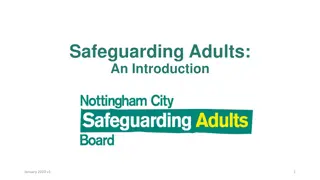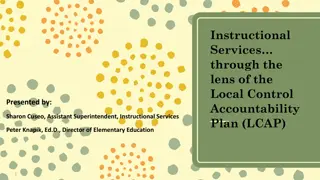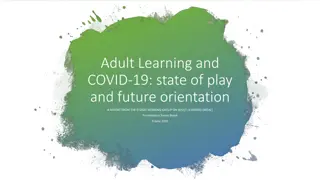Effective Instructional Methods for Adult Learners
Explore six effective instructional methods for adult learners, including advantages and limitations of each. Learn how to mitigate behavior problems associated with adult learners. Discover appropriate methods for teaching first aid, FireWise principles, disseminating policy information, and discussing new technology in smoke management.
Download Presentation

Please find below an Image/Link to download the presentation.
The content on the website is provided AS IS for your information and personal use only. It may not be sold, licensed, or shared on other websites without obtaining consent from the author. Download presentation by click this link. If you encounter any issues during the download, it is possible that the publisher has removed the file from their server.
E N D
Presentation Transcript
Facilitative Instructor M-410 Unit 8-Instructional Methods Slide 8-1
FACILITATIVE INSTRUCTOR M-410 Unit 8 Objectives 1. Identify and discuss six effective instructional methods for adult learners, and explain one advantage and one limitation of each. 2. Identify four behavior problems associated with adult learners, and describe two ways of mitigating problems. Unit 8: Instructional Methods Slide 8-2
FACILITATIVE INSTRUCTOR M-410 Effective Instructional Methods Instructor lead training (ILT) On-line course modules (OCM) Blended (both ILT and OCM) Unit 8: Instructional Methods Slide 8-3
FACILITATIVE INSTRUCTOR M-410 Effective Instructional Methods Case study Conference Demonstration Discussion group Field trip Lecture or speech Role playing Seminar Workshop Unit 8: Instructional Methods Slide 8-4
FACILITATIVE INSTRUCTOR M-410 Effective Instructional Methods Getting acquainted activities (ice breakers) Simulations Unit 8: Instructional Methods Slide 8-5
FACILITATIVE INSTRUCTOR M-410 Effective Instructional Methods Needs assessment Displays Storytelling Unit 8: Instructional Methods Slide 8-6
FACILITATIVE INSTRUCTOR M-410 What methods would be most appropriate and why? Teaching a first aid class to your crew. Educating communities on FireWise principles. Disseminating information about a new agency policy. Discussing new technology in smoke management. Unit 8: Instructional Methods Slide 8-7
FACILITATIVE INSTRUCTOR M-410 Behavior Problems or Differences Silent student Student with anxiety Student who occasionally expresses their needs in unacceptable ways Unit 8: Instructional Methods Slide 8-8
FACILITATIVE INSTRUCTOR M-410 Behavior Problems or Differences Emotionally ill student Student who is younger or older, less experienced, or new to the organization Unit 8: Instructional Methods Slide 8-9
FACILITATIVE INSTRUCTOR M-410 Behavior Problems or Differences Student using electronic devices Student reading a newspaper or other material Student late for class Unit 8: Instructional Methods Slide 8-10
FACILITATIVE INSTRUCTOR M-410 Behavior Problems or Differences Student leaving at inappropriate times Student with learning disabilities Unit 8: Instructional Methods Slide 8-11
FACILITATIVE INSTRUCTOR M-410 Mitigating Behavior Problems Share your feelings with the group Accept the feelings of others Redirect questions or comments Use the LEAST method Unit 8: Instructional Methods Slide 8-12
FACILITATIVE INSTRUCTOR M-410 Unit 8 Objectives 1. Identify and discuss six effective instructional methods for adult learners, and explain one advantage and one limitation of each. 2. Identify four behavior problems associated with adult learners, and describe two ways of mitigating problems. Unit 8: Instructional Methods Slide 8-13























